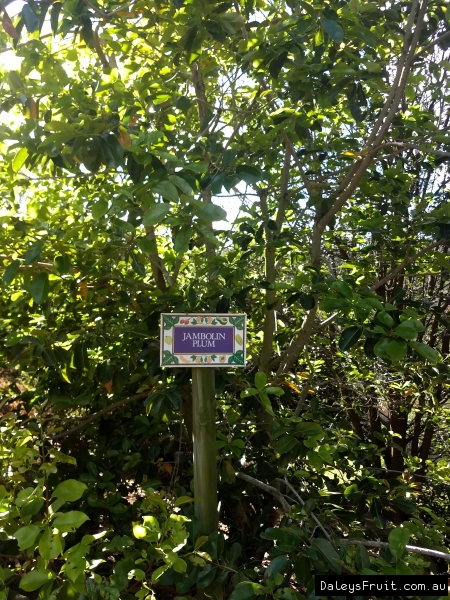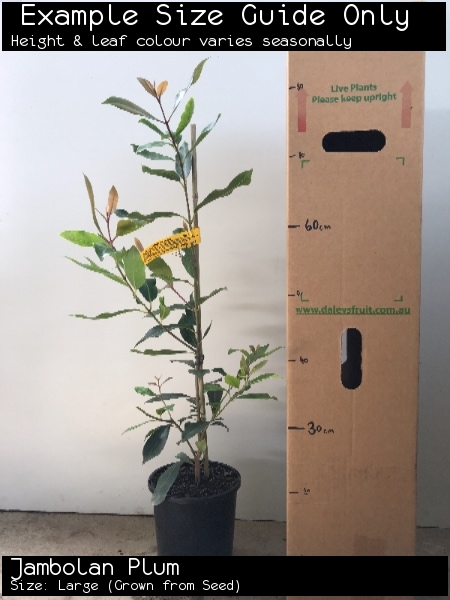Jambolan Plum
Syzygium cumini$19.75 ($19.75-$34.00 choose a size)
Specifications of Jambolan Plum
Preferred Climate Tropical, SubtropicalLearn About Climate Zones
Grown From CuttingLearn About Propagation Methods
Max Height (when in the ground with good conditions) +10m
Plants required to Pollinate 1 (Self Pollinating)Learn about Pollination
Can it Handle Frosts? Likes Temps above 5deg
Amount of leaves in Winter? All Leaves (Evergreen)
Quarantine Restrictions to these Areas SA, WA
Water Requirements Moderate Watering
Time to Fruit/Flower/Harvest 4-5 Years
Sun or Shade Full (Sun:80%-100%)
Preferred Soil Type Good Drainage
Soil pH Neutral (6.6-7.3pH)
Fruiting/Harvest Months February, March
Create a Filter to find similar plants
Customers also bought
These plants are often purchased together. Also check plant information for suitability in your orchard.
Sandalwood - Indian
$99.00 ($29.00-$99.00 choose a size)
Pepper - Black
$29.00 ($29.00-$39.00 choose a size)
Custard Apple - Golden Emperor
$79.00 ($79.00-$99.00 choose a size)
Carambola Starfruit - Daleys Sweet Gold
$79.00
Dwarf Apple - Tropical Anna
$39.00 ($39.00-$79.00 choose a size)
Pomegranate - Azerbaijani
$39.00 ($24.00-$89.00 choose a size)
Customer Tips & Reviews Jambolan Plum
SPRINGVALE SOUTH, VIC
Jambolan Plum
Grown up eating this fruit, was unable to find the plant for 30 years
Cheltenham , NSW , Australia
Jambolan Plum
I have 3 Jamun trees 4 years old, 3-4 meter tall and very healthy. No flowers so far. I had 250gms Jamun 7 in number / very big in size like Golf ball. I eat the jamuns and brought 7 seeds and all seeds were germinated. I am waiting for the fruits to get
Woodville Gardens, SA, Australia
Jambolan Plum
This in known as Jamun , I had three plant at my home and given free about 10 plant, now they are 7 year old , usually give fruit in 10 to 12 year , my plant hight is 4 and half meter
Hoppers Crossing, VIC, Australia
Jambolan Plum
I am growing one for last 4 years. Melbourne's temperate climate doesn't seem to bother it, it is about 2m high now. But no flower yet.
Jambolan Plum
As a kid , growing up in Natal, South Africa , we had numerous trees in our farm. The common name used for this fruit in Natal is MADONI. There was a bush variety also which grew near small creeks. We called this bush madoni. The fruit is much sweeter.
Jambolan Plum
Hi Monkeyboy,Seeds of JAMBOLAN PLUM, fondly known as the jamun is rich in anti-diabetic properties. Jamuns contain hydrolysable tannins, anthocyanins, and ellagic acid all of which are known to lower both blood and urine sugar levels considerably to treat Diabetes. (This Information is only for educational purposes)Dear Monkeyboy,Would you please specify the exact locations of Java Plum trees in University of Southern Queensland.Regards
Jambolan Plum
Lilly-Pilly with very nice fruit, eaten fresh. Easy to grow, fast growing, and produces fruit in subtropics easily. I used a hedge as a windbreak for coastal winds and it worked well.
Bennett Springs, WA, Australia, Australia
Jambolan Plum
Also known as Jamun, Jambhul/jambu/jambula/jamboola, Java plum, jamun, jaam/kalojaam, jamblang, jambolan, black plum, Damson plum, Duhat plum, Jambolan plum, or Portuguese plum. Malabar plum
Jambolan Plum
There are four large trees that fruit well at USQ in Toowoomba, which get light- moderate frost.
Jambolan Plum
Jambolan Plum (Jamun as it is known in India) has several applications in Ayurveda (traditional Indian medicine). It is of benefit to diabetic patients. It can be preserved with salt and taken for digestive problems and mild food poisoning.






























